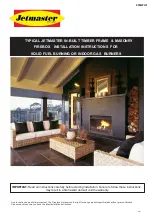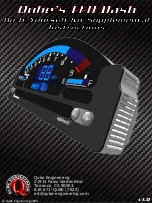
Audio DSP with AEC, 4-in/4-out analog, 4-in/4-out Dante and USB
-17-
3.3.6 Feedback filters
After setting proper levels for microphone and speakers, the feedback filter section can be used as a secondary precaution to
avoid unwanted feedback. The traditional methods should still be used, such as limiting the number of open microphones,
minimizing the distance between sound source and microphone, good distance between the microphone and loudspeakers, and
equalizing the room speakers to get a flat response. Later, we can adopt feedback filters to get additional gain. The feedback
filters cannot be used to magically solve the system's design defects or improve the sound transmission gain in a way exceeding
the system's physical limitations.
The feedback filter module automatically detects and prevents feedback in the sound system. The module distinguishes
feedback from expected sounds based on the characteristics of the signal. When feedback at a certain frequency is detected, a
notching filter will be automatically added at this frequency to attenuate it. During the first addition, the notching filter only
attenuates the feedback a bit. If the feedback still exists, the notching filter will continue to attenuate the feedback in accordance
with the preset parameters until the feedback disappears or reaches the maximum preset parameter. Multiple user parameters
can be used for accurate fine tuning of the effects of the module.
After tuning, the filter may be locked up to prevent any change during the performance. The filter settings can be copied to a
dedicated notching filter module (parametric equalizer). Eight filters are set as auto filters in an automatic cycle. In this way,
filters for temporary use can be removed.
Each channel has a feedback filter section. Click on/off button to enable or disable the filter section. Each feedback filter module
has 8 narrow-band filters.
The feedback filter module has the following adjustable parameters:
Panic Threshold:
According to this parameter, "any signal higher than the threshold is absolutely a feedback". When a signal
level is higher than the feedback threshold, any of the following circumstances will occur:
(a) the output gain is temporarily attenuated to control the speed of feedback
(b) the output level is restricted to prevent out of control
(c) the filter's sensitivity is increased for faster detection and feedback
Once the output level is lower than the threshold, the gain will be recovered, and the sensitivity is restored to normal state. This
value refers to the peak value of digital range signal. If the value is set as 0, this function is disabled.
Feedback Threshold:
Signal below this threshold will not be analysed by the feedback filter section.
Filter Depth:
Refers to the maximum attenuation of a single filter. A low setting may prevent over-processing effects caused by
the filter or notching filter. It may cause worse feedback control, especially in a large narrow resonance system.
Bandwidth:
1/10 and 1/5 Octave can be chosen. The filter will not become wider due to the increase of depth. In the case of
frequent feedback, the bandwidth can be set at 1/5Oct for a wider bandwidth.
Preset:
There are four built-in presets: "big music room", "small music room", "big voice room" and "small voice room". These
four presets apply to the default settings of most applications.
















































